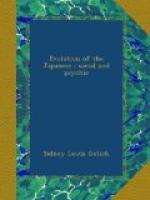Those who trace racial and civilizational nature to brain development cannot gain much consolation from a comparative statistical study of race brains. De Quatrefages’s conclusion is repeatedly forced home: “We must confess that there can be no real relation between the dimension of the cranial capacity and social development."[Z] “The development of the intellectual faculties of man is, to a great extent, independent of the capacity of the cranium and the volume of the brain."[AA]
We may conclude at once, then, that Japanese intellectual peculiarities are in no way due to the size of their brains, but depend rather on their social evolution. Yet it will not be amiss to study in detail the various mental peculiarities of the race, real and supposed, and to note their relation to the social order.
In becoming acquainted with the Japanese and Chinese peoples, an Occidental is much impressed with their powers of memory, and this especially in connection with the written language, the far-famed “Chinese Character,” or ideograph. My Chinese dictionary contains over 50,000 different characters. The task of learning them is appalling. How the Japanese or Chinese do it is to us a constant wonder. We assume at once their possession of astonishing memories. We argue that, for hundreds of years, each generation has been developing powers of memory through efforts to conquer this cumbersome contrivance for writing, and that, as a consequence for the nations using this system, there is now prodigious ability to remember.
It is my impression, however, that we greatly overrate these powers. In the first place, few Japanese claim any acquaintance with the entire 50,000 characters; only the educated make any pretense of knowing more than a few hundred, and a vast majority even of learned men do not know more than 10,000 characters. Some Japanese newspapers have undertaken to limit themselves in the use of the ideograph. It is said that between four and five thousand characters suffice for all the ordinary purposes of communication. These are, without doubt, fairly well known to the educated classes. But for the masses, there is need that the pronunciation be placed beside each printed character, before it can be read. Furthermore, we must remember that a Japanese youth gives the best years of his life to the bare memorizing of these symbols.[AB]




